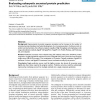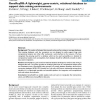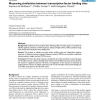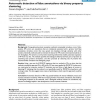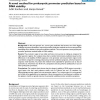BMCBI
2005
13 years 11 months ago
2005
Background: Improvements in protein sequence annotation and an increase in the number of annotated protein databases has fueled development of an increasing number of software too...
BMCBI
2005
13 years 11 months ago
2005
Background: The analysis of biological data is greatly enhanced by existing or emerging databases. Most existing databases, with few exceptions are not designed to easily support ...
BMCBI
2005
13 years 11 months ago
2005
Background: Gene set enrichment analysis (GSEA) is a microarray data analysis method that uses predefined gene sets and ranks of genes to identify significant biological changes i...
BMCBI
2005
13 years 11 months ago
2005
Background: Translational research requires taking basic science observations and developing them into clinically useful tests and therapeutics. We have developed a process to dev...
BMCBI
2005
13 years 11 months ago
2005
Background: Collections of transcription factor binding profiles (Transfac, Jaspar) are essential to identify regulatory elements in DNA sequences. Subsets of highly similar profi...
BMCBI
2005
13 years 11 months ago
2005
Background: In two-channel competitive genomic hybridization microarray experiments, the ratio of the two fluorescent signal intensities at each spot on the microarray is commonly...
BMCBI
2005
13 years 11 months ago
2005
Background: Liquid chromatography coupled to mass spectrometry (LC/MS) has been widely used in proteomics and metabolomics research. In this context, the technology has been incre...
BMCBI
2005
13 years 11 months ago
2005
Background: Computational protein annotation methods occasionally introduce errors. Falsepositive (FP) errors are annotations that are mistakenly associated with a protein. Such f...
BMCBI
2005
13 years 11 months ago
2005
Background: In the post-genomic era, correct gene prediction has become one of the biggest challenges in genome annotation. Improved promoter prediction methods can be one step to...
BMCBI
2005
13 years 11 months ago
2005
Background: Several data formats have been developed for large scale biological experiments, using a variety of methodologies. Most data formats contain a mechanism for allowing e...
